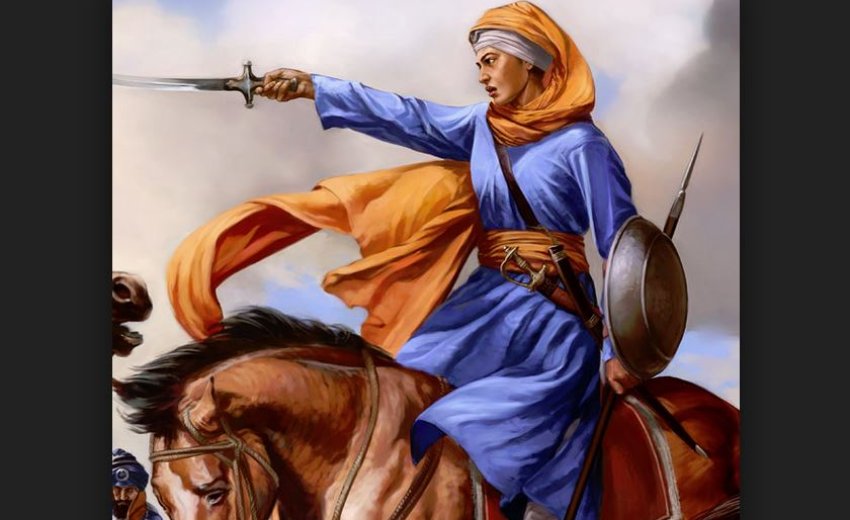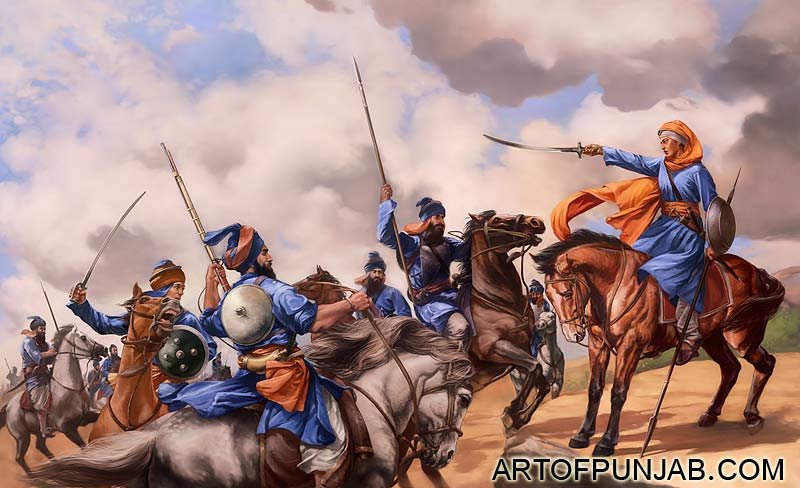Kanwar Singh's long awaited painting of Mata Bhag Kaur was unveiled at the New York City Sikh Art and Film Gala over the weekend and will continue to be exhibited across North America and the UK over the next few months.
Mai Bhago, (Mata Bhag Kaur) the sole survivor of the battle of Khidrana, i.e. Battle of Muktsar (29 December 1705), was a staunch Sikh by birth and upbringing. In 1705 she was distressed to hear that some of the Sikhs of her neighbourhood who had gone to Anandpur to fight for Guru Gobind Singh Ji had deserted him under adverse conditions.
Finding the men she persuaded them to find the Guru, to apologize for leaving Anandpur while it had been under attack and seek his permission to be reinstated as Sikhs. She set off along with them and some other Sikhs to find the Guru, who had been pursued by Mughal forces since leaving Anandpur. They caught up with him in the area around Malva. Mat Bhago and the men she was leading stopped near the dhab (pool) of Khidrana just as an imperial army was about to attack the Guru. The 40 sikhs who had asked the Guru for permission to leave Anandpur, had been allowed to leave, but the Guru had asked them first to leave the Khalsa and dis-avowing him as their Guru. Now fate gave them the chance to redeem themselves, nevermind that even though they appeared as Sikhs, they were no longer Khalsa, so despite the fact that they surely faced certain death, the forty (chali) men along with Mai Bhago, waded headlong into the Muslim forces (around 10,000 soldiers) and inflicted so much damage that the Muslims were finally forced to give up their attack and retreat as darkness fell to lick their wounds in the nearby woods. The Guru had watched the battle from a nearby hill and with deadly accuracy had rained down a flurry of arrows on the Mughal fighters during the attack. Seeing little activity among the party that had come to his aid he rode to the battlefield.
He found that group was composed of the forty men who he had asked to sign a paper dis-avowing him as their Guru, all of them had died of their wounds except one, Mahari Singh, who mortally wounded, had only the time to look up at Guru Gobind Singh as he pulled him upright with his arms pulling him into his lap. It is said that the note the men had signed slipped out of the dying Sikh's clothing and was picked up by the Guru who told Mahari Singh that all was forgiven that all were forgiven and had died as Martyrs.
Sri Guru Gobind Singh Ji blessed the forty men as the forty (chali) liberated ones (mukte) and that is still how the men are known today; the Forty Liberated Ones the Chali Mukte. He took Mata Bhago into his care and healed her battle injuries. After recovering she thereafter stayed on with Guru Gobind Singh Ji serving as one of his bodyguards, in warrior attire. After the passing of Guru Gobind Singh at Nanded in 1708, she retired down at Jinvara, 11 km from Bidar in Karnataka where, immersed in meditation, she lived to attain a ripe old age.
Her hut in Jinvara has now been converted into Gurudwara Tap Asthan Mai Bhago. At Nanded, too, a hall within the compound of Takht Sachkhand Sri Hazur Sahib marking the site of her residence is known as Bunga Mai Bhago.
Kanwar Singh says: "Mai Bhago is one of the most famous figures in Sikh history and a story that every Sikh child hears at an early age. I wanted this to be the most ambitious painting I could conceive so that it could be equal to the story of this tremendous Sikh heroine."
This inspiring painting is available as an Artist Signed Canvas print limited to 250 copies. Once the edition limit is met, these prints will no longer be available on canvas. Please visit the artist's online Gallery for more details including image close ups, sizes & prices.


